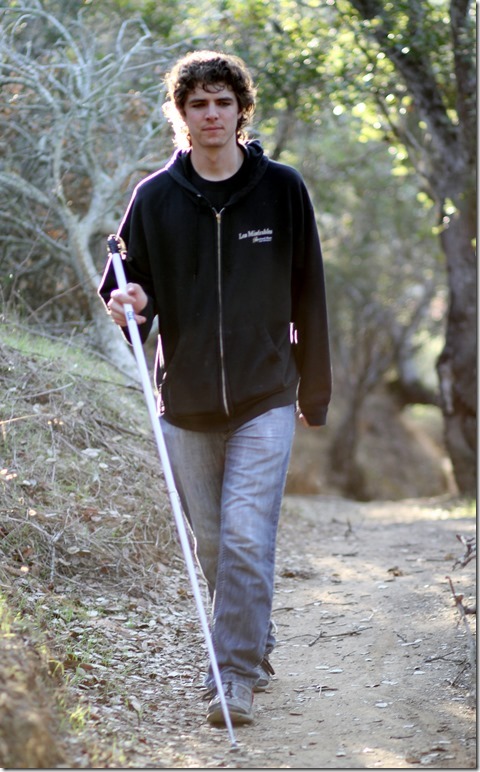Living with LCA: Brandon Biggs

Brandon Biggs has Leber congenital amaurosis, specifically a mutation of the CRB1 gene. Pictured: Brandon walking a trail in the woods with his white cane. Photo courtesy Biggs family.
Brandon Biggs was diagnosed with vision loss — and ultimately with Leber congenital amaurosis (LCA) — as a toddler. His genetic mutation is LCA-CRB1, which can cause LCA, retinitis pigmentosa (RP) and cone-rod dystrophy. CRB1 is the second highest incidence (10%-13%) of the nearly 30 different LCA genes that cause the disease.
His mother, Sonja Biggs, described in a telephone interview from her California home that despite all her now-26-year-old son’s accomplishments, she still has her “Mom moments,” triggering grief for her son’s vision loss.
What we discovered in exploring Brandon’s story for our series “Living with LCA” is that different members of his family have differing views of their journey with this rare inherited retinal disease. And so we invited the Biggs family to each share their story revolving around Brandon — mom Sonja, dad Atom, and wife Claudia.
But first, a little about Brandon himself: In pursuing his master’s degree in Inclusive Design, Brandon is writing his thesis exploring multimodal representations of data. He is focusing on creating auditory maps for blind people showing, for instance, where the hurricane is in Texas, or where the wildfires are in California. He is also working on making auditory graphs, so blind students won’t be required to always read tactile graphs.
“As technology is developing faster and faster,” Brandon says, “it is becoming more and more difficult to make sure technology is accessible to blind users, especially in the work environment.”
As a business owner, Brandon sees how difficult it is for a blind person to work in a small business. “I evaluate systems, such as for accounting, payroll, HR, timekeeping, document storage . . . and it is scary that for many crucial systems, there are few accessible solutions and no user-friendly solutions (for the blind).
“I just evaluated around 20 accounting systems and there were only two systems that were partly accessible; all the others were completely inaccessible. This means that blind people who work at all with accounting can only successfully work at companies that use those two systems, and only about half as efficiently as their sighted counterparts. This half-efficiency is because the experience of the blind user was not taken into consideration when the system was developed.”
Despite these issues, Brandon is actively working with companies to make their systems more accessible. He performs user-experience reviews for companies and writes evaluations of their products from a blind user’s perspective. He recently evaluated Intuit’s QuickBooks Online, and Intuit invited him in to see what they are working on.
“They are very slowly making changes that I recommended, but it is very slow. There are two guys on accessibility out of the 8,000 employees at Intuit, and that is considered to be a big accessibility team.”
All the more reason that Brandon is devoting his life to making sure blind people have quality access to technology.
